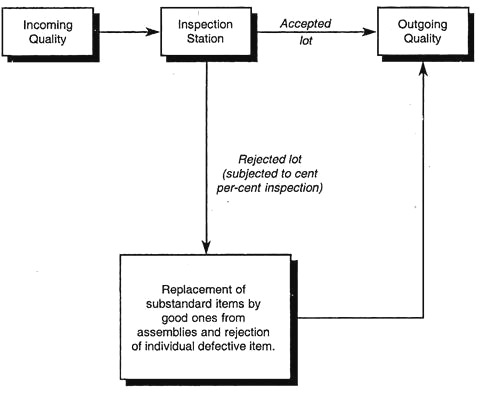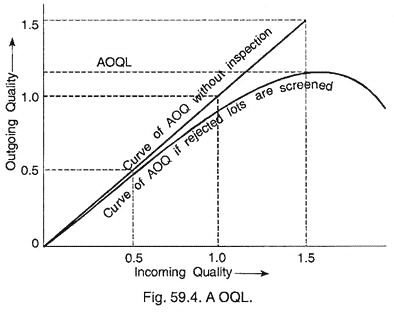After reading this article you will learn about:- 1. Meaning of Acceptance Sampling 2. Role of Acceptance Sampling 3. Quality Indices.
Meaning of Acceptance Sampling:
Sampling is the tool or technique of statistical quality control. Webster defined a sample as a product to represent the quality of the whole lot. Frequently, we in our daily life come in contact with sampling.
For example, if we purchase a bag of potatoes, only a few potatoes can be observed from the whole bag however we draw an inference about the whole bag by only inspecting a few. If these look alright, it is assumed that all the potatoes in that bag will be alright.
The basic concept of sampling lies in testing the samples for acceptance or rejection. Some products such as electric bulbs, radio valves, razor blades, bolts etc. require to be subjected to destructive tests so as to ascertain their life.
ADVERTISEMENTS:
A cent percent inspection and destructive testing of such type of products cannot be possible and also sometimes the cost of cent percent inspection is extremely high. So for such problems acceptance sampling can be widely used.
In this method samples are collected at regular interval and subjected for inspection.
For the purpose of acceptance, inspection is carried out at many stages in the process of manufacturing. These stages may be: inspection of incoming materials and parts, process inspection at various points in the manufacturing operations, final inspection by a manufacturer of his own product and finally inspection of the finished product by the purchaser.
ADVERTISEMENTS:
Inspection for acceptance is generally carried out on a sampling basis. The use of sampling inspection to decide whether or not to accept the lot is known as Acceptance Sampling.
A sample from the inspection lot is inspected, and if the number of defective items is more than the stated number (the number is decided using statistics after a decision is taken about confidence level depending upon the place of application of the product and its criticality) known as Acceptance Number, the whole lot is rejected.
The purpose of Acceptance Sampling is, therefore, to decide whether to accept or reject the lot. It does not control the quality during the process of manufacturing.
Role of Acceptance Sampling:
Acceptance Sampling is very widely used in practice due to the following merits:
ADVERTISEMENTS:
1. Acceptance Sampling is much less expensive than 100 percent inspection.
2. It is general experience that 100 percent inspection removes only 82 to 95 percent of defective material. Very good 100 percent inspection may remove at the most 99 percent of the defectives, but still cannot reach the level of 100 percent. Due to the effect of inspection fatigue involved in 100 percent inspection, a good sampling plan may actually give better results than that achieved by 100 percent inspection.
3. Because of its economy, it is possible to carry out sample inspection at various stages. Acceptance number is evaluated using sampling plan and confidence level.
4. The 100 percent inspection is not possible, where quality can be tested only by destroying the items. In such case, sampling inspection is the only solution.
Quality Indices for Acceptance Sampling:
ADVERTISEMENTS:
Quality indices for acceptance sampling plan are:
1. Acceptance Quality Level (AQL):
It is a fraction defective that can be tolerated without serious effect on further processing operation or customer reaction. In other words, AQL is the maximum percent defective that, for the purpose of sampling inspection, can be considered satisfactory as a process average. AQL can also be termed as maximum number or percentage of defective pieces in a ‘good lot’.
2. Rejectable Quality Level (RQL):
ADVERTISEMENTS:
This is also known as ‘lot tolerance percent defective (LTPD)’. It represents the percentage defectives in a lot that can be tolerated in only as specified proportion of lots. By adopting a sampling plan that will reject most of the lots offered that would cause too much unfavourable reaction of the customer.
This, RQL helps in real protection against unsatisfactory material, reaching the customer. RQL or LTPD can also be expressed by the minimum number or percentage of defective pieces in a “bad lot”. This can also be termed as ‘Limiting Quality Level’ (LQL).
3. Average Outgoing Quality Limit (AOQL):
This is the limit of quality, worst than which a consumer will not get in any lot.

